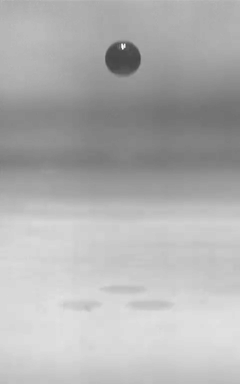![]() German
German
| Wet particle impact |
|

Sphere bouncing on a wet plate
(5X slower than real time)
|
The normal coefficient of restitution, first introduced by Isaac Newton in 'The mathematical principles of natural philosophy' (Corollary VI) as the relative rebound over the impact velocities, provides a convenient way of characterizing the energy dissipation associated with the impacts of spherical particles. It is not only a material property as Newton assumed, but also depends on the impact velocity, dimension of the particles, surface properties, etc. It represents the energy dissipation from viscoelasticity, plastic deformation, mechanical waves, friction, adhesion, etc. Understanding the energy dissipation is one of the most fundamental questions to decipher wet granular dynamics. A reliable `microscopic' impact model facilitates large scale computer simulations of wet granular flow in terms of efficiency and accuracy and sheds light on widespread applications in civil and chemical engineering. The goal is to understand:
|
References
|
|
Universität Bayreuth -


